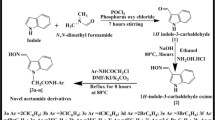Abstract
A series of amide derivatives of 3,4,5-trihydroxyphenylacetic acid was synthesized in two steps. The antioxidant activities were evaluated by using four different in vitro models such as ABTS and DPPH radical scavenging activity and FTC and TBA anti-lipid peroxidation activity. Most of compounds were more powerful radical scavengers than vitamin C and were comparable to Trolox. It was found that there were no direct correlations between radical scavenging and anti-peroxidation activities. The inhibitory activity of compound on lipid peroxidation showed remarkable dependency on both the number of phenolic hydroxyl group and the length of methylene linker in N-arylalkyl group of amide. Compound 14, a conjugate of 3,4,5-trihydroxyphenylacetic acid and dopamine, was found as powerful antioxidant as propyl gallate in all four antioxidant assays.
Graphical Abstract
A series of amide derivatives of 3,4,5-trihydroxyphenylacetic acid was synthesized. The antioxidant activities were evaluated by using four different in vitro models such as ABTS and DPPH radical scavenging activity and FTC and TBA anti-lipid peroxidation activity. Compound 14, a conjugate of dopamine, was found as powerful antioxidant as propyl gallate in all four antioxidant assays.




Similar content being viewed by others
References
Belin, F., P. Barthélémy, K. Ruiz, J.M. Lacombe, and B. Pucci. 2003. Synthetic gallic acid derivatives as models for a comprehensive study of antioxidant activity. Helvetica Chimica Acta 86: 247–265.
Çetinkaya, Y., H. Göçer, A. Menzek, and İ. Gülçin. 2012. Synthesis and antioxidant properties of (3,4-Dihydroxyphenyl)(2,3,4-trihydroxyphenyl) methanone and its derivatives. Archiv der Pharmazie 345: 323–334.
Chan, E., C.Y. Wong, C.W. Wan, C.Y. Kwok, J.H. Wu, K.M. Ng, C.H. So, A.L. Au, C.C. Poon, S.W. Seto, Y.W. Kwan, P.H. Yu, and S.W. Chan. 2010. Evaluation of anti-oxidant capacity of root of Scutellaria baicalensis georgi, in comparison with roots of polygonum multiflorum thunb and panax ginseng CA Meyer. American Journal of Chinese Medicine 38: 815–827.
Du, J., C. Miao, X. Zhang, I.-H. Jeong, E.M. Son, S. You, B.-J. Lee, and D.-K. Kim. 2011. Antiproliferation of hela cells by 3,4,5-trihydroxy-N-[2-p-tolylethyl]-benzamide is associated with induction of DNA damage and inhibition of DNA replication. Toxicology in Vitro 25: 1535–1541.
Erkan, N., G. Ayranci, and E. Ayranci. 2008. Antioxidant activities of rosemary (Rosmarinus officinalis L.) extract, blackseed (Nigella sativa L.) essential oil, carnosic acid, rosmarinic acid and sesamol. Food Chemistry 110: 76–82.
Fiuza, S.M., C. Gomes, L.J. Teixeira, M.T. Girão Da Cruz, M.N.D.S. Cordeiro, N. Milhazes, F. Borges, and M.P.M. Marques. 2004. Phenolic acid derivatives with potential anticancer properties—A structure–activity relationship study. Part 1: Methyl, propyl and octyl esters of caffeic and gallic acids. Bioorganic and Medicinal Chemistry 12: 3581–3589.
Gülçin, İ. 2012. Antioxidant activity of food constituents: An overview. Archives of Toxicology 86: 345–391.
Halliwell, B., and S. Chirico. 1993. Lipid peroxidation: Its mechanism, measurement, and significance. The American Journal of Clinical Nutrition 57: 715S–724S.
Huang, D., B. Ou, and R.L. Prior. 2005. The chemistry behind antioxidant capacity assays. Journal of Agriculture and Food Chemistry 53: 1841–1856.
Kikuzaki, H., and N. Nakatani. 1993. Antioxidant effects of some ginger constituents. Journal of Food Science 58: 1407–1410.
Lu, Z., G. Nie, P.S. Belton, H. Tang, and B. Zhao. 2006. Structure–activity relationship analysis of antioxidant ability and neuroprotective effect of gallic acid derivatives. Neurochemistry International 48: 263–274.
Navarro-Perán, E., J. Cabezas-Herrera, L. Sánchez-Del-Campo, F. García-Cánovas, and J.N. Rodríguez-López. 2008. The anti-inflammatory and anti-cancer properties of epigallocatechin-3-gallate are mediated by folate cycle disruption, adenosine release and NF-κB suppression. Inflammation Research 57: 472–478.
Niki, E., E. Komuro, M. Takahashi, S. Urano, E. Ito, and K. Terao. 1988. Oxidative hemolysis of erythrocytes and its inhibition by free radical scavengers. Journal of Biological Chemistry 263: 19809–19814.
Ottolenghi, A. 1959. Interaction of ascorbic acid and mitochondrial lipides. Archives of Biochemistry and Biophysics 79: 355–363.
Pal, C., S. Bindu, S. Dey, A. Alam, M. Goyal, M.S. Iqbal, S. Sarkar, R. Kumar, K.K. Halder, M.C. Debnath, S. Adhikari, and U. Bandyopadhyay. 2012. Tryptamine-gallic acid hybrid prevents non-steroidal anti-inflammatory drug-induced gastropathy. Journal of Biological Chemistry 287: 3495–3509.
Pratt, D.A., K.A. Tallman, and N.A. Porter. 2011. Free radical oxidation of polyunsaturated lipids: New mechanistic insights and the development of peroxyl radical clocks. Accounts of Chemical Research 44: 458–467.
Re, R., N. Pellegrini, A. Proteggente, A. Pannala, M. Yang, and C. Rice-Evans. 1999. Antioxidant activity applying an improved ABTS radical cation decolorization assay. Free Radical Biology and Medicine 26: 1231–1237.
Sato, Y., S. Kamo, T. Takahashi, and Y. Suzuki. 1995. Mechanism of free radical-induced hemolysis of human erythrocytes: Hemolysis by water-soluble radical initiator. Biochemistry (Moscow) 34: 8940–8949.
Siquet, C., F. Paiva-Martins, J.L.F.C. Lima, S. Reis, and F. Borges. 2006. Antioxidant profile of dihydroxy- and trihydroxyphenolic acids-A structure–activity relationship study. Free Radical Research 40: 433–442.
Valko, M., D. Leibfritz, J. Moncol, M.T.D. Cronin, M. Mazur, and J. Telser. 2007. Free radicals and antioxidants in normal physiological functions and human disease. The International Journal of Biochemistry and Cell Biology 39: 44–84.
Vijayavel, K., R.D. Gomathi, K. Durgabhavani, and M.P. Balasubramanian. 2004. Sublethal effect of naphthalene on lipid peroxidation and antioxidant status in the edible marine crab Scylla serrata. Marine Pollution Bulletin 48: 429–433.
Wu, J., H. Sugiyama, L.H. Zeng, D. Mickle, and W. T-W. 1998. Evidence of trolox and some gallates as synergistic protectors of erythrocytes against peroxyl radicals. Biochemistry and Cell Biology 76: 661–664.
Yang, Y., R. Sharma, J.-Z. Cheng, M.K. Saini, N.H. Ansari, U.P. Andley, S. Awasthi, and Y.C. Awasthi. 2002. Protection of HLE B-3 cells against hydrogen peroxide- and naphthalene-induced lipid peroxidation and apoptosis by transfection with hGSTA1 and hGSTA2. Investigative Ophthalmology and Visual Science 43: 434–445.
Acknowledgments
The research was supported by the Bisa Research Grant of Keimyung University in 2012.
Author information
Authors and Affiliations
Corresponding author
Rights and permissions
About this article
Cite this article
Kim, J., Hong, V.S. & Lee, J. Antioxidant activity of 3,4,5-trihydroxyphenylacetamide derivatives. Arch. Pharm. Res. 37, 324–331 (2014). https://doi.org/10.1007/s12272-013-0189-0
Received:
Accepted:
Published:
Issue Date:
DOI: https://doi.org/10.1007/s12272-013-0189-0




